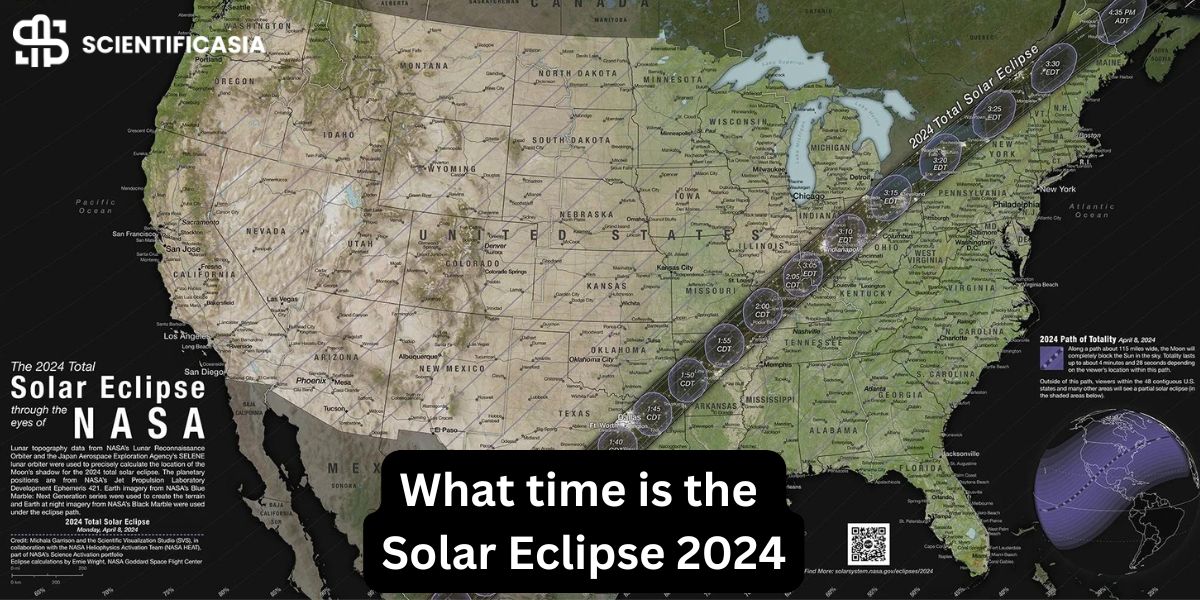What time is the solar Eclipse 2024? This was a hot topic at the early start of the year. The space agencies had predicted a complete solar eclipse which came true. Yes On 8th April 2024, we witnessed a total solar eclipse. And it was the best experience that will last for a lifetime as that solar eclipse 2024 was a total eclipse that covered the sun’s visible light completely! The solar eclipse 2024 path of totality was across the regions of America, Canada, and Mexico before coming to an end across 700 kilometers southwest of Ireland.
Solar Eclipse – Quick Intro
Before diving into the details of the solar eclipse 2024, let us understand what a solar eclipse is in the first place. This phenomenon occurs when the Moon gets in front of the Sun during its rotation. It passes between the Earth and the sun, covering the sun completely. This is called a solar eclipse, and it blocks sunlight from Earth. Solar eclipses can obscure the sun partially or completely, depending on the diameter of the moon. A solar eclipse occurs approximately every 6 months or so. This is a natural process, but cannot be viewed from specific regions across the world depending on the time of occurrence. A solar eclipse can be seen in a smaller portion compared to a lunar eclipse.
Related Blog: Astronomy Information: Everything from the Ground Up
Some ancient cultures also considered solar eclipses as some supernatural creatures covering the sun but as science progressed the explanation came forward. Still, people from various sects and beliefs link it to bad omens.
What is Total Eclipse 2024?
The solar eclipse 2024 path of totality was complete. The Moon’s diameter was larger and covered the sun completely allowing only small amounts of solar prominences to pass through. Many people witnessed complete darkness in some areas, like at night! The details of this solar eclipse 2024 are as follows:

After this total solar eclipse in 2024, the next estimated solar eclipse with a similar width will take place in 2045! So, take advantage of this chance to have a lifetime experience.
2024 Solar Eclipse Path and Times
The solar eclipse 2024 was visible across different regions of America. The path of the rotation and revolution of the moon that caused the total solar eclipse on 8th April 2024 started from the strip of the Pacific Ocean. From there, it passed 60 kilometers (approx) moving to the North of Penrhyn atoll. This is 115 kilometers south of Starbuck Island. The strip was darkened during the daytime and later moving onto the same path, the 2024 solar eclipse became visible across the North American areas, first at the Mexican coasts, after which it moved to the northeastern direction passing onto Canada.

Eclipse Viewing 2024 Schedule
Here is the detailed summary of What time is the Solar Eclipse 2024 across different regions of the world.
America
The totality first started from the Revillagigedo Islands (Mexican state of Colima). After getting darker there, it moved towards the Islas Marias of Nayarit. After reaching the mainland, the path of totality of the eclipse crossed several Mexican states, including Sinaloa (covering Mazatlán), northern Nayarit, Durango (encompassing Durango City and Gómez Palacio), southeastern Chihuahua, and Coahuila (which included cities like Torreón, Matamoros, Monclova, Sabinas, Ciudad Acuña, and Piedras Negras). The rest of the country experienced a partial eclipse, with Mexico City witnessing 79% coverage of the solar disc. Torreón was the largest Mexican city directly in the path of totality.
America is the continent that witnessed most of the Total Eclipse of 2024. All major states saw the totality, including Texas, Oklahoma, Missouri, Tennessee, Illinois, Kentucky, Ohio, Michigan, New York, Northern Vermont, New Hampshire, and Marine. All the parts of these states were lucky enough to see the dark in the daytime!
Canada
So, What time is the Solar Eclipse 2024 in Canada? It happened at 10: 40 am PDT and stayed around more than 8 hours. However, the first few hours saw a partial eclipse. Totality appeared around 3: 12 pm EDT. Moving from the US, totality was seen across different regions of Canada. Please were seen making videos of the totality of the solar Eclipse through the regions of Southern Ontario.
Europe
Europe did not experience a total eclipse like America. However, people still witnessed a partial eclipse on 8th April across different regions. These include Svalbard (Norway), Ireland, and other areas of the United Kingdom. Portugal and Spain were cloudy at the time of totality, although a partial eclipse was visible to the people of Western Scotland.
Oceania
Hawaii, Tokelau, and Eastern Kiribati regions also saw a partial eclipse 2024. However, the date was not 8th April here due to timezone changes. The eclipse was seen on Tuesday, April 9th at UTC+13 or UTC+14.
Recommended Viewing Sites
For the best views of the eclipse, Astronomy magazine highlighted 20 prime locations that wereideal for experiencing totality., It stretches from west to east across North America. Starting on the Pacific coast in Mazatlán, Sinaloa, Mexico, these spots offer clear skies and easy access, continuing through scenic towns like Nazas in Durango and Piedras Negras in Coahuila.
In Texas, popular spots include the Radar Base, Kerrville, Lampasas, and Hillsboro, as well as Sulphur Springs. As the path moves northeast, Russellville, Arkansas, and Cape Girardeau, Missouri, provide excellent vantage points, with Vincennes and Indianapolis in Indiana also being great options.
Heading further east, Ohio offers two prime locations in Lima and Cleveland, while Erie, Pennsylvania, and the iconic Niagara Falls in New York add spectacular backdrops to the celestial event. The solar eclipse 2024 start time and end time across these scenic places was 2:04 pm and lasted till 4:32 pm.
Buffalo, Plattsburgh, and Sherbrooke in Quebec were also ideal, culminating in Mars Hill, Maine, as one of the final recommended viewing sites. These locations were perfect for eclipse chasers seeking an unforgettable experience with optimal visibility and accessibility.
Here is a Video from Quebec: Total Solar Eclipse Montreal Quebec April 8, 2024
Conclusion
What time is the solar eclipse 2024 was a hot topic at the start of the year. People who witnessed the totality solar eclipse in April experienced a lifetime of visuals. This blog covered all the important aspects of the 2024 solar eclipse path and times, highlighting the top sites blessed with complete daytime darkness. The eclipse times are also covered in this blog for those who are looking to dive deeper into the details. Overall, solar eclipse 2024 was a lifetime experience as the same type of eclipse is not expected in the coming decade.
FAQs
What time is the solar eclipse 2024 in Florida?
The total eclipse started on Apr 8, 2024, at 1:47 pm and was at maximum potential at 3:01 pm in Florida. It ended on Mon, Apr 8, 2024, at 4:13 pm after 2 hours, 26 minutes.
What time is the solar eclipse 2024 in Georgia?
The total eclipse started on Apr 8, 2024, at 1:45 pm and was at maximum potential at 3:04 pm in Georgia. It ended on Mon, Apr 8, 2024, at 4:21 pm after 2 hours, 35 minutes.
What time is the solar eclipse 2024 in NY?
The total eclipse started on Apr 8, 2024, at 2:10 pm and was at maximum potential at 3:25 pm in NY. It ended on Mon, Apr 8, 2024, at 4:36 pm after 2 hours, 26 minutes.
What time is the solar eclipse 2024 in New Mexico?
The total eclipse started on Apr 8, 2024, at 11:16 am and was at maximum potential at 1:47 pm in New Mexico. It ended on Mon, Apr 8, 2024, at 4:36 pm after 2 hours, 31 minutes.
What time is the solar eclipse 2024 California?
The partial eclipse started on Apr 8, 2024, at 10:03 am and was not visible fully in the region. It ended at 12:31 pm.
Also, keep up with the Scientific Asia community on Facebook and Twitter.












